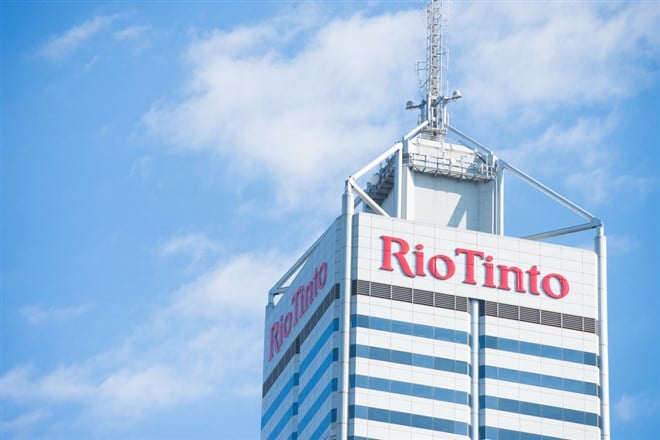
Rio Tinto (NYSE: RIO) shares traded lower by 1.87% on Thursday's session, fresh off the news that management has decided to cut its dividend to $2.25 per share, down from $4.17 a year earlier. As it is natural for commodity-based businesses to fluctuate in both stock price and business fundamentals wildly along with the swings in prices of the underlying commodities they operate within, Rio Tinto's profits have been significantly affected by Iron Ore's price decline for the better half of the year 2022.
A reported 38% decline in year-over-year earnings, as shown in their latest press release of results, and the segmented highlight of revenues being derived mostly from China (to 53% as of 2022) sheds some light on what is going on within the business.
China dependency
Historically for Rio Tinto, China has represented more than half of their net revenues as they became the nation's largest iron ore provider. This relationship and positioning have served them well over the past few years. Iron ore is an essential basic material for developing infrastructure, something China has been very busy doing this past decade. However, as they say, you can't have your cake and eat it too.
Following years of high demand and reliable orders by China, the nation has come to a slowdown during the strict period of lockdown policies - which thankfully are looking to be eased - thus highly affecting revenues and outlooks for the iron ore giant.
Chief Executive Officer Jakob Stausholm stated on an earnings call that the property market in China, a significant source of revenue for Rio, is currently in "good shape" following the recent steep slowdown.
However, despite such an optimistic outlook on China's revenue recovering as the nation reopens and resumes orders for further property and infrastructure projects, Rio Tinto seems to be in sync with the new tendency to decouple from Chinese dependency... or so they made markets think.
Same face, new name
Sticking with China as a major buyer is pretty clearly given for Rio. However, the focus seems to be changing rapidly from the material that helped China become the developed nation it is today to the material that will make it the nation of the future. As the United States and China have been fighting toe to toe on a sort of solar race, the two powerhouses have been investing heavily into renewable energy - namely solar panels - and installing aggressively across their cities.
For those who aren't physicists or chemists, solar panels require two main components to work, and those are polysilicon and copper. Polysilicon would be a weird and difficult market for a metals company to enter into, so why not give the good old college try to a market like copper?
How much CAPEX is into growth projects? Yes. That is a paraphrased conversation between C-suite executives within Rio - not actually, but close - the company has effected a $3.1 billion acquisition of Turquoise Hill Resources. Turquoise Hill is a Canadian mining company specializing in copper/gold exploration. But wait, there's more; Turquoise's main asset is a Mongolian copper/gold mine company named Oyu Tolgoi.
This $3.1 billion acquisition represents 66% of the firm. At the same time, the Mongolian government owns the remaining 34%, sort of creating a bypass into lobbying opportunities and a more "relaxed" operating vertical for operations into this new market focus.
Could a shift to focus on copper allow Rio Tinto to tap into the renewable energy revolution in the two most powerful nations in the world? If they successfully pull this off, how does Rio stand against China's largest copper provider Vale S.A. (NYSE: VALE).
Unlimited resources or nothing to lose?
They say that the only opponent more dangerous than one with unlimited resources has nothing to lose. Is Rio Tinto former or the latter in this showdown to win China's copper demand against Vale?
To understand how much maneuvering room each player has, the first question should be how much room to maneuver is there.
Starting with Rio Tinto, the focus goes to free cash flow - namely its five-year average to avoid the commodity cycle extremes - rather than net income, which can be affected by non-operating items:
- With a five-year average free cash flow of $11.17 billion USD, and previous guidance to pay out 60% in dividends ($6.7 billion), this would leave the company with an expected average free cash flow of $4.5 billion. This remainder leaves little to no room for acquisitions or expansion CAPEX when their net debt of $3.36 billion is considered.
- This dynamic has been recognized by management, who voted to reduce their payout to 30% until further notice. This may leave more breathing room for continued acquisitions and growth CAPEX for their copper dominance objective. With a 19% debt mix in its capitalization, a dividend cut is nothing but appropriate to pursue a potentially huge new wave for the firm.
Stacking these stats against the Chinese copper provider of choice, Vale:
- With a similar five-year average free cash flow of $10.2 billion USD and a 2022 dividend payout of $12 billion, the gap remains in the inability to find enough growth CAPEX projects to justify retaining cash for further reinvestment. CAPEX in 2022 equated to $5.4 billion, only a fraction of the dividends paid out with no breakthrough acquisitions or plans to react to their current - although comfortable - position.
- With a total debt-to-capitalization structure of ~30%, Vale finds itself in a narrower position to respond accordingly and swiftly to the poised competition to provide copper in China and the U.S. by Rio Tinto.
Far from a predictable clash, markets speak for themselves, voting Rio Tinto at 10.5x its five-year average free cash flow for valuation. At the same time, Vale is assigned a 7.6x, implying investors are willing to pay a higher premium for Rio's cash flows than those of Vale. Perhaps this is because Vale is Brazil-centered for its copper operations while Rio is looking to divide and conquer.






